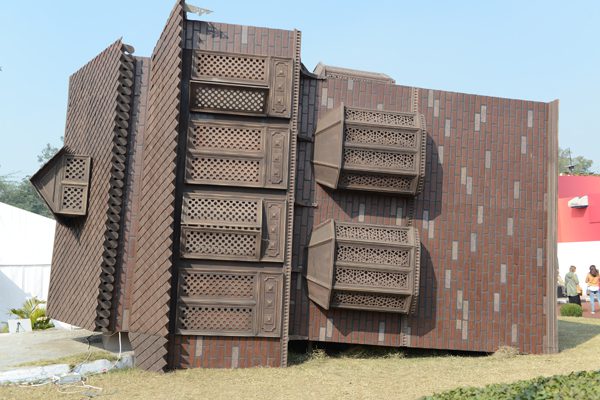Unlike many juried art fairs in the West led by a selection committee that evaluates the quality of work being displayed, the India Art Fair has been indiscriminately open to galleries across the globe. This seemingly democratic process has often resulted in a disparate show of works in the past. Artists such as Marc Quinn and Atul Dodiya have been shown alongside decorative works of glittering dancing peacocks. The resulting hodgepodge of fine art with commercial bling has dismayed collectors, museums and seasoned viewers looking for consistently high quality art.
However, the 7th edition of the India Art Fair held from 29 January – 1 February in New Delhi marked a clear distinction from the past. With art critic and curator Girish Shahane appointed as the new artistic director, the fair showcased a more cohesive body of work with a smaller selection of commercial art. Considerably pared down with fewer Western galleries that have been alienated by a weak market and prohibitive taxes in India, the fair brought understated but refreshing works by well-known Indian contemporary artists, a few newcomers, and unseen works by Indian Modernists that made a strong statement about the strength of art in India.
Newly minted drawings by emerging artists Ayesha Sultana from Bangladesh, and Prabhakar Pachpute at Experimenter were sold out. Sultana’s three-dimensional graphite works mounted on dibond stood out for its poetic conception between material and space, while Pachpute’s charcoal drawings that reference his family of coal miners revealed an unseen world. For Bhuddadev Mukherjee at Mirchandani and Steinrucke hundreds of tiny intertwined individuals, visible only up close, that resembled bundles of straw, represented the struggling middle class in his triptych translated as Human Sea.
At Nature Morte, Seher Shah’s mesmerising architectural prints and Mithu Sen’s skeletal mixed media work the ex-river guide, reinforced the value of the works at the fair. Ketaki Sheth’s diaphanous palette of blues, greens and reds captured in a small coastal village after 25 years of black and white photography came as an exhilarating surprise, while Chandan Gomes’ images of mountains of garbage in Delhi were transformed into an eerily enchanting landscape at Photoink. A collaborative project between Asia Art Archive and Shilpa Gupta enabled new ways of thinking about archives and the art world, as much as New York gallerist Thomas Erben’s black and white photographs by Gauri Gill and Pablo Bartholomew drew viewers for stirring portraits of Rajasthani village girls and nostalgic vignettes of an era gone by.
Rarely seen sketches from the Modernist era in the 1950s and 1960s by Jogen Chowdhury captured an important time in Indian art history, as did an entire booth devoted to abstract landscape painter Ram Kumar by Sanchit Gallery. Octogenarian master painter K.G. Subramanyan’s more recent colour-filled figurative works that reference myth, memory, and tradition were strategically placed at Art Heritage Gallery, as were important works by younger artists such as abstract print maker Zarina Hashmi, and feminist paintings by Nalini Malani at Vadhera Gallery.
The Art Projects strand consisted of indoor and outdoor works specifically curated by Shahane. Much like the rigor of the works at the concurrent Kochi Muziris Biennale in south India, these artists addressed pressing contemporary issues with a new and forceful tenacity. T. V. Santhosh’s The Threshold into a Dream, of a precariously tilted wooden replica of the Victoria Terminus railway station in Mumbai that was bombed by Islamic militants in 2008 is fitted with numerous digital clocks that recall the exact time the bombs went off. Veer Munshi’s Serenity of Desolation, pays homage to homes and lives lost in the recent flood in Kashmir through his barebones house and wall filled with sepia toned portraits of the missing. A four day painting-as-performance collaboration between artists Dhruvi Acharya and Chitra Ganesh combined Acharya’s odd cartoon like women with Ganesh’s mythological female figures drawn from Indian comic series to produce an alluring figurative painting of bright colours and imaginative forms.
Shahane’s seamless inclusion of curators, art historians, art critics and artists in a well-organised Speakers’ Forum added a lively dimension to the fair that incorporated a discussion of the place of south Asian art in the world. The India Art Fair formerly known as the India Art Summit is poised to grow into a better place. Buoyed by the strength of indigenous artists, the fair is a standalone entity even without the ratification of well-known galleries from London. Although dampened by some cosmetic art that catered to a market that is relatively new to the tradition of collecting, the 7th edition of the India Art Fair has ushered in a new era for a gradually discerning audience.
India Art Fair, 29 January – 1 February, C/o Seventh Plane Networks Pvt. Ltd., HS 37, 1st Floor, Kailash Colony Market, New Delhi – 110 048, India.
Bansie Vasvani
Credits
1. Veer Munshi, Serenity of desolation, image courtesy of India Art Fair.





